Prevention and Relief of Navicular Problems
Frog Management 4-14-06 Pete Ramey
Copyright 2006
Recent (Dr.
Robert M. Bowker) and not-so-recent (Dr. James R. Rooney)
research has shown us that problems in the navicular region are
caused by unnatural use or specifically a lack of use of the
back of the foot. (Please read
Digging for the Truth about
Navicular Syndrome in the Articles section of
www.hoofrehab.com)
We once thought of navicular disease (damage to or remodeling of
the navicular bone) as a primary problem, but now look at it as
a simple symptom of long term toe-first impact, a lack of frog
pressure, and/or peripheral loading (forcing the hoof wall to
bear all the weight without natural help from the frog, bars and
sole). This knowledge has rightfully caused us to panic if our
horses frequently land toe-first and to have deep concern if
they have dysfunction in the back of the foot.
In these feral cadavers (front feet), notice the prominence of
the frog. This horse came from the rockiest terrain I have ever
seen and these tough frogs gave the protection, traction and
front-line energy absorption the horse needed for the rigorous
lifestyle.
In the previous
articles, "Heel Height – the Deciding Factor" and "Boots
and Pads – a Breakthrough in Healing" we
discussed the importance of trimming to achieve correct
heel-first impact and thus frog stimulation and beneficial
shortcuts to frog development we can reap from boot and pad use.
In this article,
we’ll discuss frog trimming and management. Many horses are
stuck in a pattern they can't easily escape. The frogs are too
weak, infected with fungus and lack the callusing necessary to
be the natural, front-line impact zone nature intended. If the
frog is too sensitive to impact the ground, the lack of
stimulation reduces growth and makes callusing and digital
cushion development impossible, thus it is a “wheel-spinning”
vicious cycle for hoof managers. While thoughtful heel height
trimming and the use of hoof boots with padded insoles help
break this pattern, the proper trimming and management of the
frog itself is critical.
After the setup trim we should very often leave the frogs alone.
Neither of these frogs have been trimmed at all in the past
year, and both horses are all-terrain gravel crunchers.
It would take exactly one pass through these frogs with a hoof
knife to make boots a necessity on rocky terrain for the next
three-four months! Too many professionals keep the horses in
their care sensitive to rocky ground simply by over-trimming the
frogs and never give it a moment's thought.
An often overlooked, but very important factor is the diet of the horse. The most common reason diabetic humans are hospitalized is foot pathology. Number two is diminished skin wound healing. A key feature of any metabolic stress is a shutdown of nutrition to the extremities. High insulin levels increase keratin growth. High glucose levels decrease keratin growth (skin, hair, hoof, laminae, sole and frog). Unnatural, high sugar/starch diets can have the same devastating effect to the frogs that we see in the horses' laminae. Read http://www.hoofrehab.com/LaminitisUpdate.html.
Most vitamin, amino
acid and
mineral deficiencies/imbalances also degrade frog integrity,
yielding increased vulnerability to fungal and bacterial
infection and slower tissue growth. Read Feeding the Hoof.
That said, from a
physical standpoint, constant pressure and release stimulation
is the real hero with any frog improvement. Everything we do
with trimming, pads and living terrain should focus on this.
Every time you trim a frog, you should consider these four
things the trim may be accomplishing:
1) The removal
of “flaps” that harbor destructive fungus and bacteria (frog
trimming is healthy).
2) The removal
of external callusing that protects the frog from destructive
fungus and bacteria (frog trimming is harmful).
3) The removal
of excess frog height/pressure that can cause sensitivity
(frog trimming increases comfort).
4) The
thinning of the frog’s protective barrier between the sensitive
corium and the terrain can overexpose nerves to pressure
(frog trimming causes lameness and bruising).
If this thoroughly
confused you, you're on the right track to learning some
important lessons. There are no simple answers, so you should
carefully consider each factor before you pull your hoof knife
out of your pocket. Let’s wade through these contradictions one
by one.
The removal of
“flaps” that harbor destructive fungus and bacteria.
The flaps that
commonly fold over the central sulcus and the collateral grooves
may naturally form to hold dirt in place within the grooves to
help support the center of the foot (Ovnicek, Bowker). Leaving
these flaps alone usually works well in dry areas similar to the
high desert biomes most of our horses evolved for. In wet
environments or when horses are stabled in close quarters, these
“flaps” can harbor mud, manure, and be an ideal breeding ground
for harmful microbes. In these environments it is usually best
to trim away these flaps so the grooves can self-clean; this is
especially important at the central sulci.
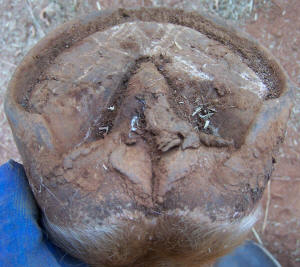
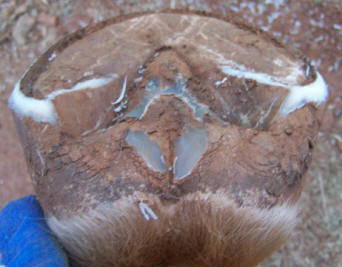
The frog tends to callus in the correct shape and thickness if the horse is barefoot and excess wall length is not allowed. If you look for the body of the frog, you should be able to visualize the shape of the inner structures, the frog's natural shape and the flaps that protrude from it. You should usually remove the flaps only and avoid any temptation to "make it prettier" by trimming deep into the frog. It is particularly important to open the central cleft. This "opening" should parallel the inner structures without thinning the needed frog material. Follow the natural shape of the body of the frog into the cleft at the center of the frog.
While opening these
flaps, try to preserve as much of the surface callus as
possible. This preserves some soundness and usability of the
frog, helping the horse callus the frog into this more hygienic
shape so you don’t have to repeat the trimming at every
maintenance trim.
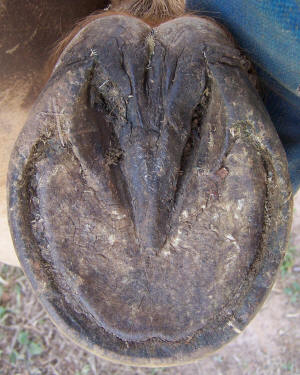
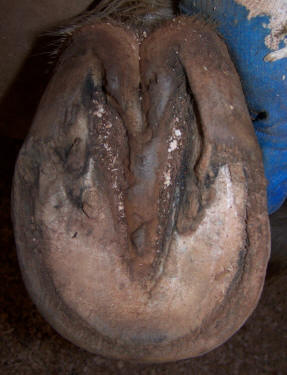
These are contracted
frogs. The digital cushions and lateral cartilages are
underdeveloped. The frog's corium is pinched together
(thus closer to the ground) and the body of the frog flows into
the deep collateral groove with no excess material built up.
There is no room here for trimming to open the central sulcus;
both would be easily quicked and any trimming will increase
sensitivity. The right photo shows a partially shed frog, but
the new frog growing in underneath is still immature. Pea
gravel, foam boot insoles, anti-fungal soaking, constant
barefoot stimulation and thousands of heel first landings are
needed to build adequate inner structure and healthier frogs. I
see no trimming that needs to be done to either one; both are
too thin, now.
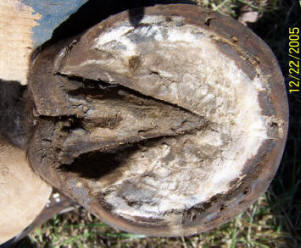
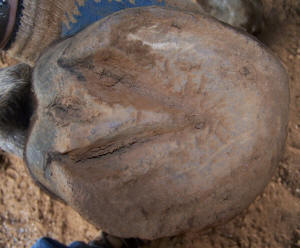
See this horse in the
Under the
Horse DVD Series: The deep thrush persisted
through a year of other treatments we tried, then cleared up in
6 weeks with the "New Goo"-- a 50/50 mixture of Bacitracin Cream
and Athletes Foot Cream (1% Clotrimazole) injected daily into
the bottom of the sulci with a Monoject 412, catheter tip
syringe.
Also, of course
daily hoof picking is particularly important in these
environments. Most horse owners think it is a waste of time
because the grooves are immediately filled back up with mud,
manure or dirt. They need to understand how quickly microbes can
multiply while consuming their horse. Picking out the hooves
removes high concentrations of destructive microbes next to the
“skin” even if the hoof is packed with mud again one minute later.
Hygiene is
important. I have seen too many horses that were lame simply
because of advanced fungal infection in the frogs. It is very
easy to prevent – very difficult to get rid of, once it becomes
established. If you live in a wet environment and want to see
“frog magic” try 4”-deep beds of pea gravel for a loafing
surface (under the shade tree, run-in shed, stalls, at the gate,
any area the horse spends time standing around). Place landscape
fabric under it and pick the manure from it every day with a
manure fork, and the same load of gravel will last for years.
The removal of external callusing that protects the frog from destructive fungus and bacteria.
Here’s where things
get complicated. Yes, we should often trim a frog to create
better hygiene and protection from microbes, but you must also
be aware that every time you trim away the outer callused layer
of frog material, the softer tissue you expose is a perfect
target for opportunistic pathogens.
I was originally
taught as a farrier to routinely trim the entire frog every time
I trimmed the rest of the foot. I was also taught that most
horses (shod or bare) living in our wet Appalachian environment
could be expected to get thrush every winter. When I became more
conservative with the trimming of my client’s frogs, I almost
eliminated thrush in my clientele. I had to admit to myself I
had been causing thrush for years, by routinely removing the
protective callus from the frogs.
Of course there is a time and a place to trim frogs. Just think before you do it, and have a good reason why. To make things pretty? Not a good enough reason. Flap removal for hygiene? Maybe, maybe not. It varies from horse to horse, barn to barn. Just don’t trim an entire frog because one small part of it needed a trim. Trim the part that needs attention and leave the rest untrimmed. If a frog needs a large one-time reduction, do it – but if you think a particular frog needs to have 1/8 inch layer shaved off, leave it alone.
The removal of excess frog height/pressure that can cause sensitivity.
As discussed in the
articles previously mentioned, most domestic horses have not
been allowed to roam enough to fully develop the internal
structures in the back of the foot – the lateral cartilages and
digital cushions. (Bowker) This is the most common cause of hoof
sensitivity and ultimately, navicular disease.
Hooves with fully
developed digital cushions often have tremendous frogs, often
longer than the heel walls yearning to absorb the energy of
impact. This is natural, very good news for the horse and should
be encouraged.
This horse, diagnosed with navicular disease, had been lame
during three years of heel wedging. The sole and frog coriums
have migrated to a pathologically low position in the hoof
capsule. At the setup trim I lowered the heel walls to the level
of the healthy sole plane, attempting to leave protruding frog
alone. We walked the horse and found him to be miserable, so my
next step was to immediately lower the frog to the heel height.
He was instantly more comfortable, and rideable (for the first
time in several years) in padded hoof boots. Four months later,
he no longer needed the boots.
Sometimes, however,
a frog that is longer than the heels can cause pain if the
internal structures aren’t ready for it. Often a horseshoe or a
long heel on a barefoot horse lifts the frog from its natural
impact position. The frog’s corium responds by moving towards
the ground or prolapsing. Suddenly trimming heels to a more
natural height or pulling the shoes can cause soreness because a
tremendous new excessive pressure is being applied to the weak
internal structures. Trimming the frogs can relieve this
pressure and increase comfort while the corium migrates back up
into its natural position. This is very often the right thing to
do on a “set-up” trim, BUT…….
The thinning of the frog’s protective barrier between the sensitive corium and the terrain can cause sensitivity.
Every time we trim
(thin) the frog we risk sensitivity. Most of us are too quick to
routinely trim the entire frog. It looks prettier and more
professional if the entire frog is clean, white and perfectly
shaped after a trim. But “pretty is, as pretty does.” Imagine
the calluses being routinely trimmed from your own heels every
four weeks. Can you see that it could rob your performance?
Certainly, and the horse is no different.
To really develop the skill of trimming frogs without
over-thinning the protective material, a professional should do
as many cadaver dissections as possible to become familiar with
the shape and location of the corium. If you understand the
shape of the frog's corium and understand that the bottom of the
collateral grooves are about 7/16-inch from the corium, you can
learn to paint a picture of the inner structure in your mind
when looking at the foot from the outside.
You should always leave at least 5/8-inch of frog skin
covering the sensitive structure and it is even more important
to understand that the 5/8-inch thick callused frog
horses need can take at least a year to build and compact. This
fully callused frog can never build if it is routinely cut away
at regular intervals.
If the wall and heel
heights are diligently maintained, you will find that most frogs
will callus off at the right height and need little or no
trimming. Routine frog thinning can seriously rob performance.
Even if the trim cycle is long enough that 1/4-inch of excess
heel is removed during the maintenance trim it is usually okay
to leave the frog longer than the heels. It will find the
right place in a matter of hours or days. Don’t touch it if
trimming would only accomplish shaving off the external callus.
Frog pressure is
critical for the support of the impact loaded, dropped fetlock,
the coffin joint and thus the ligaments and tendons. It is a
strong statement, but I truly believe a lack of frog support
(including too-soft terrain) is the culprit behind almost all
ligament injuries in the lower leg. Frog pressure is important
for P3 support on impact, armor plating the back of the foot and
plays a role in circulation and overall function. Too many of us
were taught to protect it or relieve it from pressure…. We need
to put it into hard work. Frog pressure is good.
If we do anything to
cause or allow sensitivity through the frog, the horse will toe
walk. This motion directly causes all known navicular problems
and most joint, tendon and ligament problems of the lower limb
It can also wreck the entire body. Toe walking can
single-handedly cause white line separation, even P3 rotation,
in spite of the best hoof care and management efforts.
Not only that, the resulting lack of frog pressure slows
frog growth and prevents protective callusing and internal
caudal foot development, perpetuating the problems.
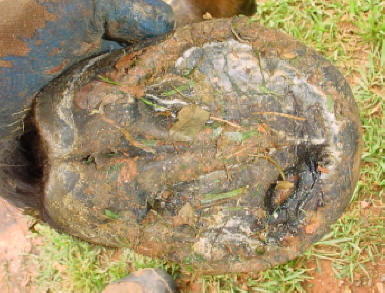
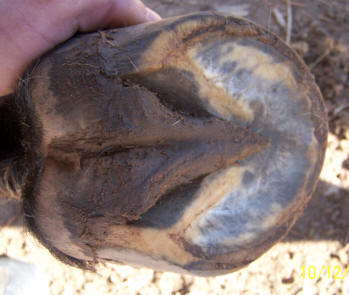
In spite of the penetrated coffin bone, this horse
actually tip-toed because of the greater pain in the back
of the foot. (Actually I think the toe walking contributed to
the P3 penetration). The photo at right is of the same hoof 18
months later – the day the horse was awarded the Annual
Speed Event Championship for our local
saddle club. He came in first in every race all year. In my
opinion, building the back of the foot was more important to
this rehab than building the new sole under P3 or growing the
well-connected wall.
This may muddy the
waters for you. Many professionals are content to routinely trim
the entire frog, while others never touch it. Performance and
comfort can be dramatically improved if more careful thought and
decision making is applied to frog trimming. Just think before
you cut! There is no such thing as a “good habit.” So much has
been written about the management of every other part of the
external foot and so little about the frog. Experience has shown
me that the decisions we make with frog trimming may be more
important than with any other part of the foot.
Most people tend to think of thrush as a wet weather problem, but in dry environments, deep, tight, infected sulci actually cause more lameness than in wet environments. The harder texture of a desert frog with an infected gash in the middle causes excruciating pain.
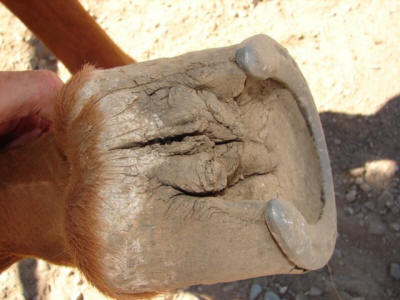
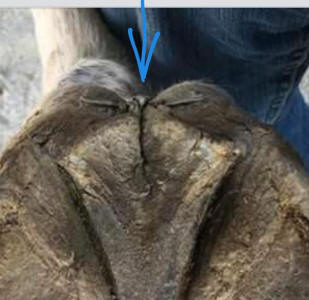
It is probably inaccurate to call this thrush, as fungal and bacterial infection were usually not the primary instigators of the problem. Instead, excess dryness and/or chronic toe-first impact probably contracts the foot first. Then, the resulting deep split at the central sulcus yields a wet, dark, anaerobic environment where opportunistic bacteria and fungi can become established even in the driest climates. These pathogens then eat deeply into the flesh in the bottom of the sulcus, causing pain, which causes more toe-first impact, which causes more heel contraction… a vicious and intensifying cycle, eventually splitting the hide and damaging the frog corium and digital cushion.
I treat desert thrush cases the same way as above, except that I also encourage horse owners to get the horse’s feet wet every day – not for so long that the foot adapts into a wet weather foot – just a few minutes of being wet each day. Simply overflowing the water trough, watering horses in a creek or dirt tank/pond works well, but when water conservation is important, just sponging the feet daily does the trick.
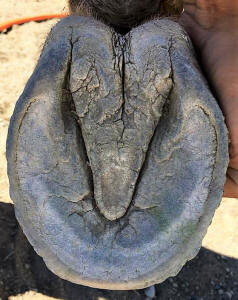
Desert Thrush - a sneaky killer.
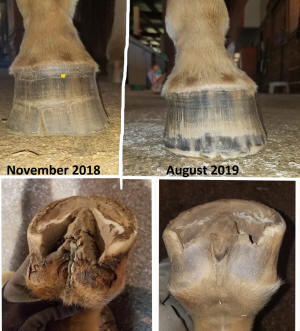
*
.jpg)

